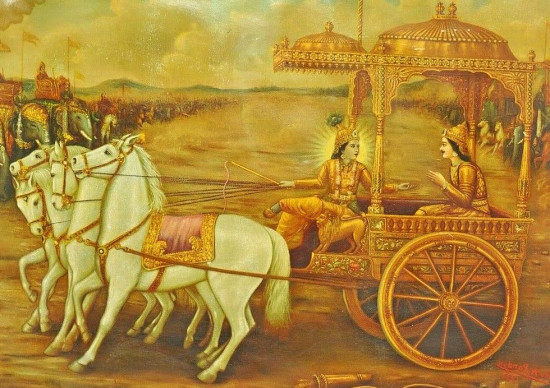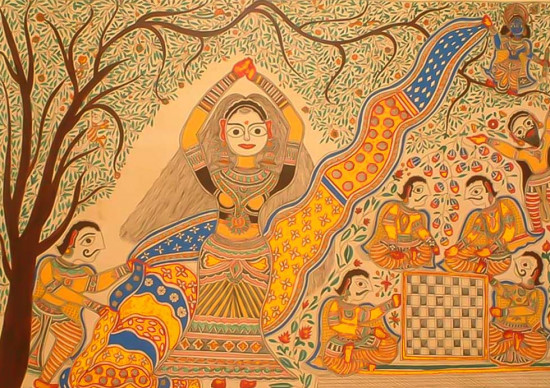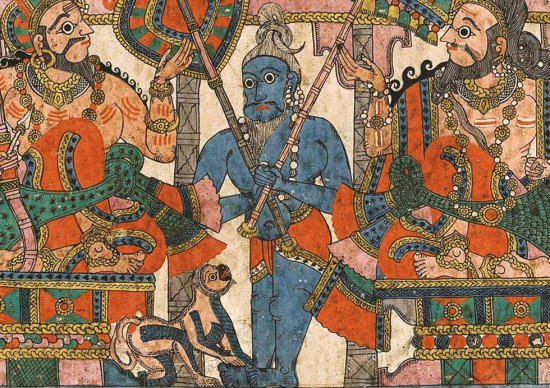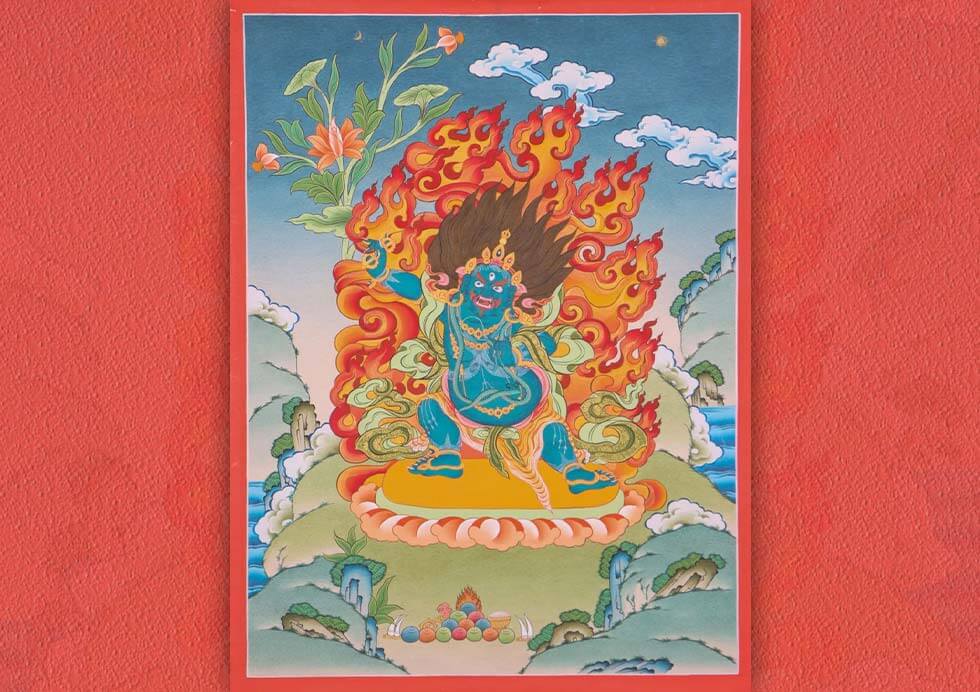
Vajrapani, often revered as the “Indestructible Hand of Buddha,” holds a prominent and powerful position in Buddhist cosmology. This bodhisattva is celebrated for embodying the enlightened energy of all Buddhas, serving as a fierce guardian, and offering transformative strength to practitioners on their spiritual journey.
The name “Vajrapani” originates from the Sanskrit words “Vajra,” meaning thunderbolt or diamond, and “Pani,” signifying hand. Hence, Vajrapani is commonly known as the “Holder of the Thunderbolt” or the “Diamond Hand.” The thunderbolt symbolizes an unshakable and indestructible force, reflecting the unwavering strength of Vajrapani.
Depicted with a fierce expression, Vajrapani’s wrathful aspect represents his role in overcoming obstacles and dispelling ignorance. In some artistic representations, he may feature a third eye on his forehead, symbolizing heightened wisdom and insight into the nature of reality.
Vajrapani is closely associated with the practice of tantra, a form of esoteric Buddhism that emphasizes ritual and meditative techniques. As a bodhisattva, Vajrapani bodhisattva has voluntarily delayed his own enlightenment to guide and assist others on their spiritual path.
Devotees turn to Vajrapani for his protective qualities, seeking strength, courage, and the removal of hindrances. In Buddhist iconography, Vajrapani is often portrayed standing or dancing, wielding a vajra (thunderbolt) in one hand and occasionally a bell in the other. The vajra signifies the indestructible nature of reality, while the bell represents wisdom, symbolizing the union of compassion and insight.
The symbolism associated with Vajrapani bodhisattva is rich and multifaceted, reflecting the multifaceted nature of Buddhist teachings. As a guardian and protector, Vajrapani helps individuals navigate challenges, overcome obstacles, and progress along the path to enlightenment. The worship of Vajrapani continues to be an integral aspect of Buddhist traditions, emphasizing the transformative power and strength available to those who invoke his presence in their spiritual practice.
The worship of Vajrapani is not limited to a specific Buddhist tradition; rather, it spans across various schools and sects. Whether in Theravada, Mahayana, or Vajrayana Buddhism, Vajrapani is recognized and venerated for his potent qualities. His presence is invoked in rituals, prayers, and meditations, where practitioners seek his assistance in overcoming obstacles and gaining spiritual insight.
The name “Vajrapani” originates from the Sanskrit words “Vajra,” meaning thunderbolt or diamond, and “Pani,” signifying hand. Hence, Vajrapani is commonly known as the “Holder of the Thunderbolt” or the “Diamond Hand.” The thunderbolt symbolizes an unshakable and indestructible force, reflecting the unwavering strength of Vajrapani.
Depicted with a fierce expression, Vajrapani’s wrathful aspect represents his role in overcoming obstacles and dispelling ignorance. In some artistic representations, he may feature a third eye on his forehead, symbolizing heightened wisdom and insight into the nature of reality.
Vajrapani is closely associated with the practice of tantra, a form of esoteric Buddhism that emphasizes ritual and meditative techniques. As a bodhisattva, Vajrapani bodhisattva has voluntarily delayed his own enlightenment to guide and assist others on their spiritual path.
Devotees turn to Vajrapani for his protective qualities, seeking strength, courage, and the removal of hindrances. In Buddhist iconography, Vajrapani is often portrayed standing or dancing, wielding a vajra (thunderbolt) in one hand and occasionally a bell in the other. The vajra signifies the indestructible nature of reality, while the bell represents wisdom, symbolizing the union of compassion and insight.
The symbolism associated with Vajrapani bodhisattva is rich and multifaceted, reflecting the multifaceted nature of Buddhist teachings. As a guardian and protector, Vajrapani helps individuals navigate challenges, overcome obstacles, and progress along the path to enlightenment. The worship of Vajrapani continues to be an integral aspect of Buddhist traditions, emphasizing the transformative power and strength available to those who invoke his presence in their spiritual practice.
The worship of Vajrapani is not limited to a specific Buddhist tradition; rather, it spans across various schools and sects. Whether in Theravada, Mahayana, or Vajrayana Buddhism, Vajrapani is recognized and venerated for his potent qualities. His presence is invoked in rituals, prayers, and meditations, where practitioners seek his assistance in overcoming obstacles and gaining spiritual insight.
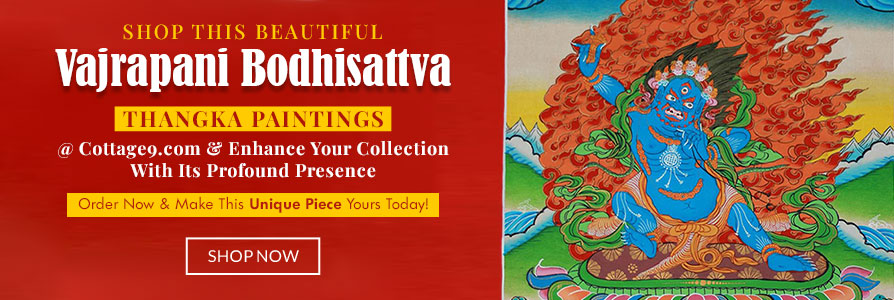
Vajrapani’s significance in Buddhist cosmology extends to his role as a guardian of the teachings. He is often invoked for protection against external and internal obstacles that may hinder one’s progress on the path to enlightenment. By cultivating a connection with Vajrapani, practitioners believe they can access his transformative energy, fortifying their resolve and perseverance in the face of challenges.
In Buddhist art, Vajrapani is portrayed in various forms, each carrying specific symbolism. Whether depicted standing or dancing, his presence exudes strength and determination. The vivid imagery associated with Vajrapani serves as a visual representation of the qualities one aspires to cultivate on the spiritual journey.
The stress on Vajrapani’s attributes is also evident in the teachings and scriptures of Buddhism. Discourses on his role as a protector, a source of strength, and a guide for navigating the complexities of existence emphasize the profound impact that connecting with Vajrapani bodhisattva can have on an individual’s spiritual development.
The veneration of Vajrapani extends beyond religious practices and has cultural implications in regions where Buddhism has left an indelible mark. Pilgrimages to temples dedicated to Vajrapani, the recitation of mantras associated with him, and participation in rituals reflect the enduring influence of this bodhisattva in the lives of Buddhist communities.
The veneration of Vajrapani extends beyond religious practices and has cultural implications in regions where Buddhism has left an indelible mark. Pilgrimages to temples dedicated to Vajrapani, the recitation of mantras associated with him, and participation in rituals reflect the enduring influence of this bodhisattva in the lives of Buddhist communities.
In Buddhist art, Vajrapani is portrayed in various forms, each carrying specific symbolism. Whether depicted standing or dancing, his presence exudes strength and determination. The vivid imagery associated with Vajrapani serves as a visual representation of the qualities one aspires to cultivate on the spiritual journey.
The stress on Vajrapani’s attributes is also evident in the teachings and scriptures of Buddhism. Discourses on his role as a protector, a source of strength, and a guide for navigating the complexities of existence emphasize the profound impact that connecting with Vajrapani bodhisattva can have on an individual’s spiritual development.
The veneration of Vajrapani extends beyond religious practices and has cultural implications in regions where Buddhism has left an indelible mark. Pilgrimages to temples dedicated to Vajrapani, the recitation of mantras associated with him, and participation in rituals reflect the enduring influence of this bodhisattva in the lives of Buddhist communities.
The veneration of Vajrapani extends beyond religious practices and has cultural implications in regions where Buddhism has left an indelible mark. Pilgrimages to temples dedicated to Vajrapani, the recitation of mantras associated with him, and participation in rituals reflect the enduring influence of this bodhisattva in the lives of Buddhist communities.

